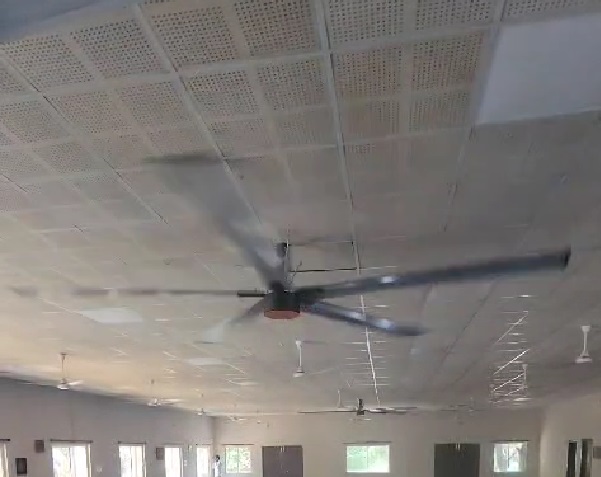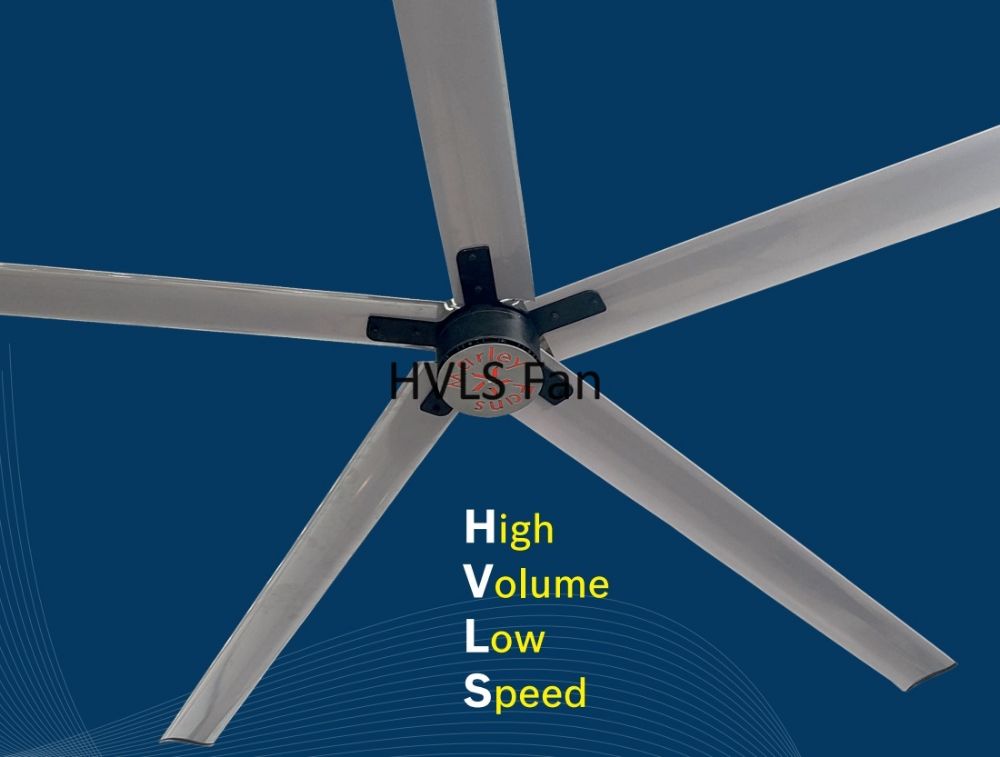HVLS Fan
What does an HVLS fan stand for?
An HVLS fan stands for High Volume Low Speed. As the name suggests these fans move large volumes of air in a given space and rotate at low speed. The typical diameter of a HVLS fan ranges from 12 feet (3.66 meters) to 24 feet (7.32 meters). HVLS fans are available in diameters of 12 feet (3.66 meters), 14 feet (4.27 meters), 16 feet (4.88 meters), 18 feet (5.49 meters), 20 feet (6.1 meters), and 24 feet (7.32 meters).
The maximum speed in RPM (Revolution Per Minute) decreases as the diameter of the HVLS fan increases.
- For example, a 12 feet diameter HVLS fan rotates at 0 to 98 RPM.
- A 14 feet diameter fan rotates at 0 to 70 RPM.
- A 16 feet diameter fan rotates at 0 to 70 RPM.
- A 18 feet diameter fan rotates at 0 to 60 RPM.
- A 20 feet diameter fan rotates at 0 to 60 RPM.
- Whereas a 24 feet diameter HVLS fan rotates at 0 to 50 RPM.
However, the air volume as measured in CFM (Cubic Feet per Minute) increases as the diameter of these HVLS fans increases and the speed decreases.
- For example, a 12 feet diameter HVLS fan delivers 138860 CFM of air volume.
- A 14 feet diameter fan delivers 154526 CFM of air volume.
- A 16 feet diameter fan delivers 185650 CFM of air volume.
- A 18 feet diameter fan delivers 324158 CFM of air volume.
- A 20 feet diameter fan delivers 345100 CFM of air volume.
- Whereas a 24 feet diameter HVLS fan delivers 402600 CFM of air volume.
A typical HVLS fan comprises 5 blades.

Where are HVLS fans used?
HVLS fans are mostly used in commercial buildings wherein a large volume of air needs to be moved. The typical applications of HVLS fans are manufacturing factories, industrial plants, automotive plants, warehouses, cattle sheds or agriculture sheds, educational institutes, indoor stadiums, and other large commercial spaces. HVLS Fans provide appropriate ventilation and air circulation thereby keeping the space fresh. This not only improves the well being and productivity of people working in these spaces but also enhances the lifespan of machinery and equipment present in these commercial places. HVLS fans are able to regulate the temperatures in hot summer months by providing uniform cooling all across the commercial space under consideration.
In Industrial plants, manufacturing factories, warehouses, automotive plants, sheds, and stadiums, the ceiling height is upward of 20 feet. And most of the time, the roof is made from insulated metal sheets. Therefore, it becomes very important to circulate the air inside the commercial space under consideration. And an HVLS fan does that effectively.
What kind of motor is in a HVLS fan?
A High Volume Low Speed Fan either uses helical geared motor or PMSM technology direct drive motor. For example, a 12 feet and a 14 feet and a 16 feet diameter HVLS fan will have a 1.1 KW helical geared motor or 0.75 KW PMSM technology direct drive motor. A 18 feet diameter and a 20 feet diameter and a 24 feet diameter fan will have a 1.5 KW helical geared motor or 1.1 KW PMSM technology direct drive motor.
How fast are HVLS fans?
HVLS fans are not fast. They are in fact low speed fans. However, because of their size and working principle, HVLS fans move a large volume of air to ventilate large spaces. The HVLS fans rotate at speeds of 0 to 98 RPM (Revolution per Minute). Bigger the diameter of these HVLS fans, the slower the speed in RPM. A 24 feet diameter HVLS fan rotates at 0 to 50 RPM. whereas, a 12 feet HVLS fan rotates at 0 to 98 RPM.
How big is a HVLS fan?
HVLS fans are big. The diameter of these fans vary from 12 feet to 24 feet. The standard sizes are 12 feet diameter HVLS fan, 14 feet, 16 feet, 18 feet, 20 feet, and 24 feet. Because of the large size and working principle, an HVLS fan is able to ventilate and cool the space under consideration.

How to choose a HVLS fan?
The process of choosing an HVLS fan can be explained in 3 steps:
- The air volume: The first step while choosing a right HVLS fan is calculating the air volume in CFM (Cubic Feet per Minute). For example, there is a factory or warehouse with a length of 200 feet and a width of 100 feet and a height of 12 feet. The volume of such a space comes out to be 240000 cubic feet. Therefore, depending on the application, the air volume that may need to be replaced per minute comes out to be either 120000 or 80000 cubic feet per minute. Therefore, for such a space, a 24 feet diameter HVLS fan will be sufficient. Likewise, based on the application and the volume of the space, the size of an HVLS fan can be chosen. It is possible that in a large factory or warehouse or industrial plant, instead of installing one HVLS fan, the engineering team may choose to install multiple HVLS fans.
- Compartments or division of the space: A space may be compartmentalized or divided in zones wherein ventilation and cooling requirements differ from one compartment or zone to another zone. In that scenario, the air volume calculations are carried out for individual compartments rather than the one full large space.
- Availability: Based on the availability of spare parts, the engineering team may choose one kind of HVLS fans over the other.
How do HVLS Fans work?
A typical HVLS fan has 3 major components:
- 5 blade architecture,
- Double reinforced bearing that helps in withstanding vertical and horizontal loads,
- And the motor. The motor can either be a PMSM motor or a Helical geared motor.
The 5 blade architecture not only gives stability to these HVLS fans but also helps in generating higher air volume in CFM.
Because of their large size, HVLS fans are heavy. And therefore, double reinforced bearing helps in sustaining the vertical and horizontal loads.
The motor technology is continuously evolving and there is an option to choose either a helical geared motor or a PMSM motor.
